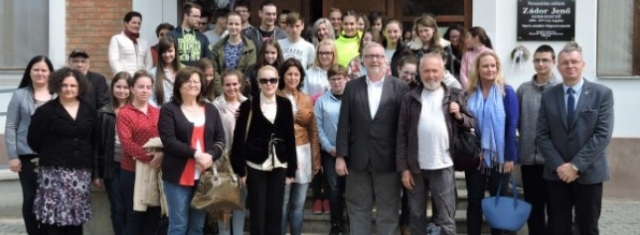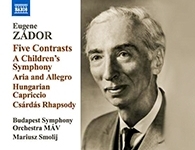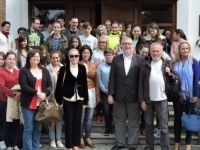Entertainment
A great orchestrator and composer Eugene Zador
Remembering the 40th anniversary

USPA NEWS -
The Hungarian Hollywood Council hold a memorial event remembering the 40th anniversary of the death of a great orchestrator and composer in Hollywood, Eugene Zador. The memorial event took place at Zador`s birthplace in Hungary.
Mayor Róbert Bozsolik opened the event and spoke about the honour Bátaszék has as a birthplace of a great musician. Ambassador Balázs Bokor, President of the Hungarian Hollywood Council delivered a powerpoint lecture on the life of Eugene Zador.
Eugene Zador was born in the village of Bátaszék, Hungary, on November 5, 1894. He started very early his piano and music career.
Eugene Zador was born in the village of Bátaszék, Hungary, on November 5, 1894. He started very early his piano and music career.
A story when he was 6 years old, goes like this:
“As he was walking home from school one day, young Zádor heard piano music coming from a neighbor´s house. He stood there listening for several hours in freezing weather. When he came down with pneumonia, his mother promised him anything if he would only recover. “And so it happened that the next day in our living room, there was a long, awful-sounding yellow piano with only five octaves, but it was a piano and it had keys. Not a bad attempt at blackmail for a six-year old.“
“As he was walking home from school one day, young Zádor heard piano music coming from a neighbor´s house. He stood there listening for several hours in freezing weather. When he came down with pneumonia, his mother promised him anything if he would only recover. “And so it happened that the next day in our living room, there was a long, awful-sounding yellow piano with only five octaves, but it was a piano and it had keys. Not a bad attempt at blackmail for a six-year old.“
Zádor studied piano and composition at the Conservatory in Pécs. In 1911, Zádor entered the Vienna Conservatory, where he studied composition with Richard Heuberger and also piano and organ. There he wrote his first orchestral composition, Jugendsymphonie, which was performed in Budapest when he was just seventeen.
In 1920, Zádor started his musicology studies with Fritz Volbach at the University of Münster. He completed his doctorate in 1921; his dissertation was titled Wesen und Form der symphonischen Dichtung von Liszt bis Strauss (Character and Form of the Symphonic Tone Poem from Liszt until Strauss).
In 1920, Zádor started his musicology studies with Fritz Volbach at the University of Münster. He completed his doctorate in 1921; his dissertation was titled Wesen und Form der symphonischen Dichtung von Liszt bis Strauss (Character and Form of the Symphonic Tone Poem from Liszt until Strauss).
In 1921, Zádor settled in Vienna, where he became a professor of composition and orchestration at the Neues Wiener Konservatorium. By then, he had already written a dozen songs and piano pieces, several chamber works, and two symphonies. The first of his twelve operas, Diana, a Grand Guignol piece about a medieval knight, was premiered at the Budapest Royal Opera House in 1923.
1935 was a very important year in Zádor´s life. His Hungarian Caprice was premiered by the Budapest Philharmonic Orchestra, Carl Schuricht conducting. This work has been performed hundreds of times since, under such conductors as Stokowski, Ormandy, Monteux, Wallenstein, Szell, and Barbirolli; and there have been three recordings of it. 1935 was the year Zádor was awarded two honorary doctorates, one from the Royal Academy of Music in Budapest and one from the New York College of Music.
Zádor had received a written offer of employment from the New York College of Music. This job offer enabled him to obtain a visa. In later years, whenever he talked about leaving Europe, he always credited his mother with the difficult decision. “War is coming,“ she warned, and urged him to go.
On March 25, 1939, Zádor boarded the Normandie at Le Havre and began the five-day voyage to New York. Among the manuscripts he brought with him was the score for a new opera, Christopher Columbus.
On March 25, 1939, Zádor boarded the Normandie at Le Havre and began the five-day voyage to New York. Among the manuscripts he brought with him was the score for a new opera, Christopher Columbus.
In December of 1939, Zádor´s Maschinenmensch Ballet Suite was performed by the Philadelphia Orchestra, Eugene Ormandy conducting; in February, 1940, his Rondo was played by the Philharmonic Symphony Society of New York, John Barbirolli conducting. Despite these successes, Zádor was worried about his future in the United States; he was struggling financially.
When he received an offer from MGM to compose music for films, Zádor took it. The pay was good, but there was no contract to guarantee a steady income. Zádor arrived in California in early February, 1940. Describing Hollywood, he wrote in a letter, “How beautiful the mountains are and how warm the sun is“¦ Here, people go in the ocean even in winter (not me).“
After composing his own music for several Hollywood films, in the late 40ies and in the 50ies MGM was keeping him very busy orchestrating Miklós Rózsa´s film scores.
After composing his own music for several Hollywood films, in the late 40ies and in the 50ies MGM was keeping him very busy orchestrating Miklós Rózsa´s film scores.
By 1963, Zádor had orchestrated over a hundred film scores, including three that won Academy Awards for best music: Spellbound, A Double Life, and Ben-Hur. Zádor composed Variations on a Merry Theme and Dance Overture in 1965, Suite for Eight Celli in 1966, and Celebration Music in 1967. Aria and Allegro (1967) proved to be one of Zádor´s biggest successes. Beginning in the 1960s, Zádor again wrote for voice. His choral works include Cantata Technica ““ Scherzo Domestico (1961), Three Rondells (1962) and Triptych for Mixed Chorus (1965). Old age did not slow Zádor down. He continued to tell wonderful stories, to make jokes, and to compose music in the 70ies.
At eighty, Zádor became a grandfather, which made him tremendously happy. He dedicated his Oboe Concerto, Yehu and a short orchestral work, Hungarian Scherzo (1975), to his granddaughter, Sabrina, born in 1975. When he first saw his grandson, Peter, born in 1976, he said, “He looks like me,“ then went home and wrote a lullaby.
Though ill and frail, Zádor was able to attend a performance of the Hungarian Scherzo. Daniel Cariaga, writing for the Los Angeles Times, called this composition “a work of undeniable, even irresistible charms.“
Though ill and frail, Zádor was able to attend a performance of the Hungarian Scherzo. Daniel Cariaga, writing for the Los Angeles Times, called this composition “a work of undeniable, even irresistible charms.“
In his final days, Zádor reminisced about Esterházy and Barrymore. He talked about how he had met his wife, and how he had come to the United States and landed a job at MGM. The loss of family members in two world wars had been profoundly sad, but Zádor remained an optimist. He was proud of his career in music and pleased to have made a good living in his adopted country: “I came to America with three dollars in my pocket. Imagine if I would have had five dollars, or ten!“
After Zádor´s death on April 4, 1977, his son Leslie published Eugene Zádor, a Catalogue of his Works and sent copies to people who had known his father. He received many letters of thanks, including this one from Winthrop Sargeant:
“Thank you for the copy of the brochure about your father´s work. I did not write to you at the time of his death, but I was greatly saddened by it. I remember the time when he came to my office at Time magazine, an impoverished refugee asking my advice. I had two tickets to a Rachmaninoff recital that evening, and I offered him one of them.
“Thank you for the copy of the brochure about your father´s work. I did not write to you at the time of his death, but I was greatly saddened by it. I remember the time when he came to my office at Time magazine, an impoverished refugee asking my advice. I had two tickets to a Rachmaninoff recital that evening, and I offered him one of them.
He was delighted to go with me, and we both enjoyed the playing of the great pianist. I also said to him, “˜Go to Hollywood. That´s where they need composers.´ And he did, and became a big success. I always liked his music as you know, and am sorry the world has lost a composer of his stature.“
Zádor was survived by his children, his grandchildren (another granddaughter, Lily, was born in 1982), and by his wife who lived to the ripe old age of 97.
Les Zador, son of the late composer sent a message to the audience of the Bátaszék memorial event.
Zádor was survived by his children, his grandchildren (another granddaughter, Lily, was born in 1982), and by his wife who lived to the ripe old age of 97.
Les Zador, son of the late composer sent a message to the audience of the Bátaszék memorial event.
“žDear Bátaszék people, My sister, Margaret Bassett, and I are grateful that the City of Bataszek will remember our father, Eugene Zador, on the 40th anniversary of his death in Los Angeles on April 4, 1977. We recall with fondness our trip to Hungary of several years ago where my father was celebrated in Bataszek--the city where he was born--and also in Pecs and Budapest with honorariums and concerts of his concert works, particularly those works with a strong Hungarian flavor.
Also, as much as we appreciated the celebrations of our dad, we also remember with heart felt appreciation the many kindnesses we were shown by the Hungarian people. We hope to come visit you again and soon. Les Zador“ A similar greeting letter was sent to Bátaszék from the Chairman of the Mensch Foundation, Mr. Steve Geiger from Los Angeles.
At the end of the event, the Mayor of Bátaszék and the President of the Hungarian Hollywood Council laid a wreath to the memorial plaque of Eugene Zador on the wall of the City`s Cultural Center.
Liability for this article lies with the author, who also holds the copyright. Editorial content from USPA may be quoted on other websites as long as the quote comprises no more than 5% of the entire text, is marked as such and the source is named (via hyperlink).







